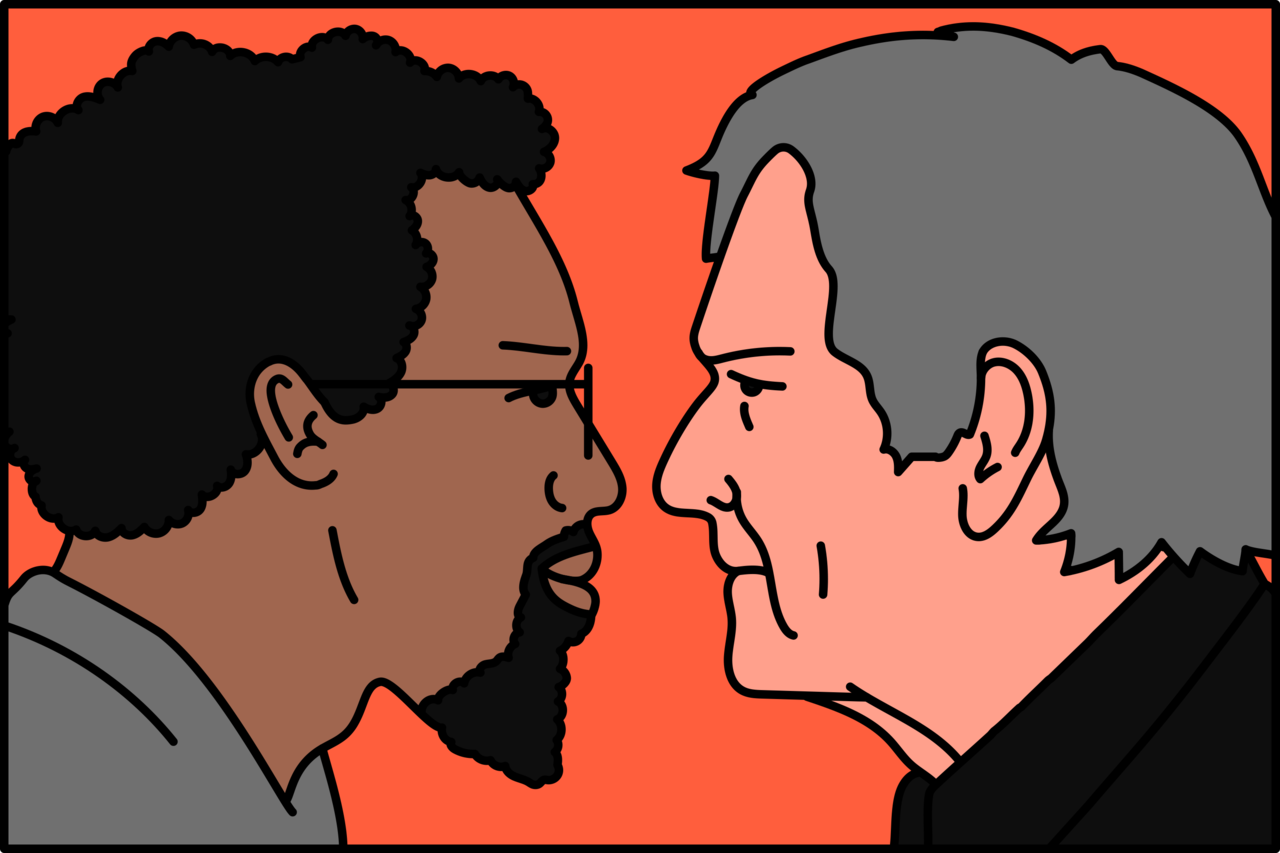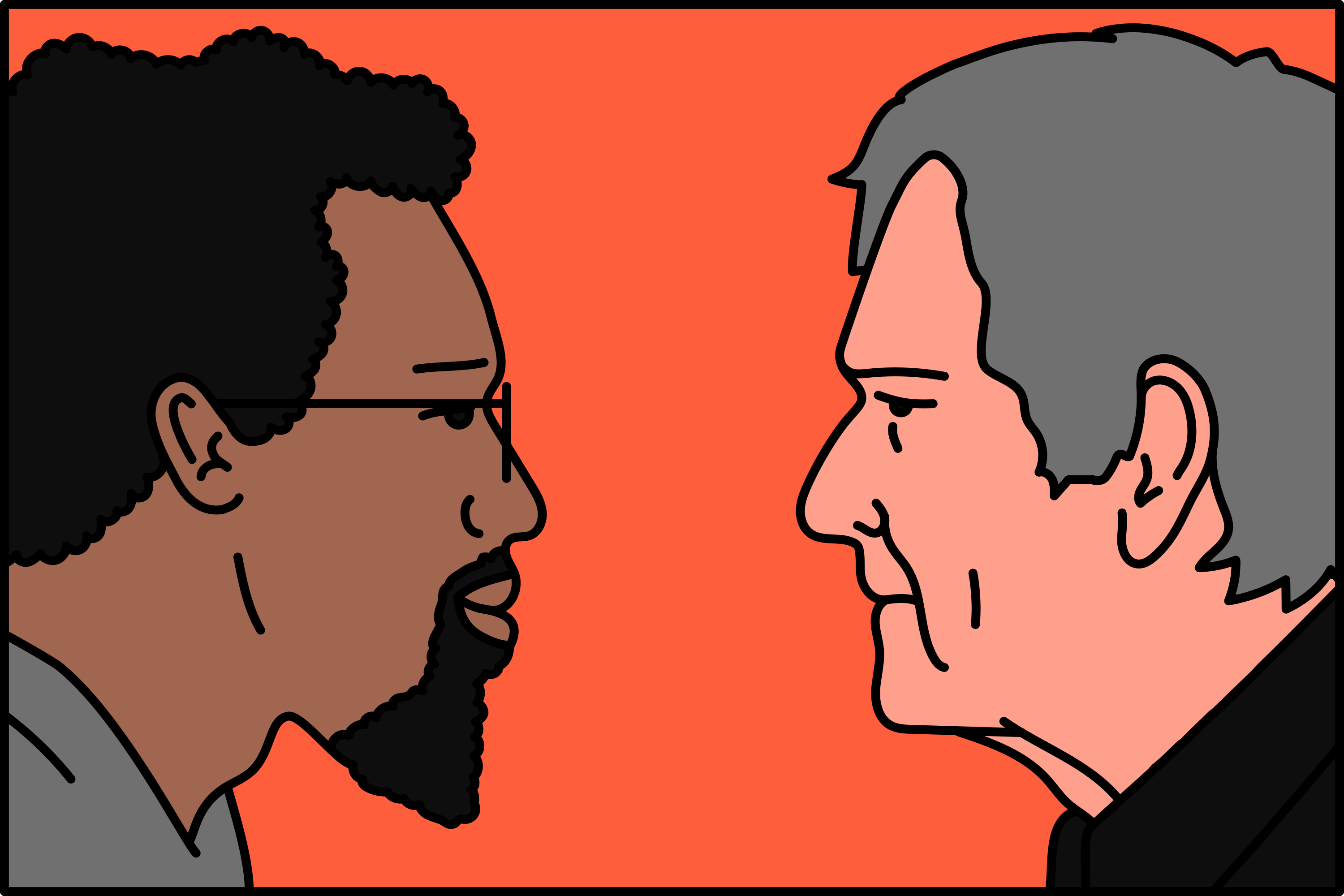
The Song Books Showdown of Julius Eastman and John Cage
Remembering an incendiary performance by the radical composer that shook up the avant-garde
It was a cooler than usual evening on the SUNY at Buffalo campus on June 4th, 1975, when Julius Eastman – a charismatic, black, openly gay composer – stepped forward. He was accompanied on the Baird Recital Hall stage by a young white man and a young black woman, identified only as Mr. Charles and Miss Suzyanna. Eastman looked around and introduced himself.
“My name is Professor Padu,” he said in a dry, droll voice that sliced through the crowd’s laughter. “And I am here to teach you a new system of love.”
He continued, “There have been many systems of love in the West which have been sort of degenerate, should we say. The first system being the main system, the In-And-Out System, which I have now revised... to the Sideway-and-Sensitive System.” The audience roared.
Buffalo at the time was an improbable hotbed of the American experimental music scene. “This conservative, provincial city became a mecca for the avant-garde starting in 1962,” says Renée Levine Packer, author of This Life of Sounds: Evenings for New Music in Buffalo, “when the private University of Buffalo became the State University of New York at Buffalo, and huge amounts of money were poured into creating a ‘Berkeley of the West,’ vastly expanding the faculty and attracting artists and intellectuals.” With funding from the Rockefeller Foundation, composers Lukas Foss and Allen Sapp created the Center of the Creative and Performing Arts to support young musicians of exceptional talent with a bent for contemporary music, and the renowned “Creative Associates” program incubated some of the most vital composers and performers in the country, including the likes of Maryanne Amacher, Terry Riley, George Crumb and Cornelius Cardew.
Julius Eastman, one such Creative Associate, was performing part of John Cage’s 1970 masterpiece Song Books – with Cage himself sitting in the audience – as a member of the experimental S.E.M. Ensemble. The Song Books consist of 92 pieces, many of them koan-like instructions to the performers that leave much to interpretation. A few overarching notes, like “we connect Satie to Thoreau,” guide the enterprise. Eastman had taken on “Solo for Voice No. 8,” which read in part: “In a situation provided with maximum amplification (no feedback), perform a disciplined action, with any interruptions, fulfilling in whole, or in part, an obligation to others.”
Eastman was transformed from insular scene hero into the mythic, inflammatory figure who challenged the foundations of the academy.
It was clear from his first words that there would be a little juice poured into Cage’s austere, Zen blend of indeterminacy and transcendence-of-self. For some music historians, this was a night that intersectionality and identity politics officially breached the avant-garde: “Eastman’s performance that day may have constituted an intersectional testing of the limits of his membership – or, in American racial parlance, his ‘place’ – in the experimental scene,” writes George E. Lewis, professor of American music at Columbia University, in the essay collection Gay Guerilla: Julius Eastman and His Music. Eastman was transformed from insular scene hero into the mythic, inflammatory figure who challenged the foundations of the academy. He would go on to write indelible works like “Gay Guerilla,” “N----- Faggot,” “Crazy N-----” and “Evil N-----,” and even help pioneer post-disco in the Manhattan dance underground as a keyboardist and vocalist for Arthur Russell’s Dinosaur L collective.
Over the next 14 minutes, Eastman delivered a bizarre lecture that focused on the erotic, but played on and exploded notions about race, colonialism and sexuality. As he invited the couple onstage with him to strip – the man ended up naked, the woman only partially so due to embarrassment – he declared them “the best specimens in the world.” Of Miss Suzyanna he said, “She comes from a special tribe which is found only in the Great Woods of Haiti.” Of Mr. Charles – blonde, almost certainly one of Eastman’s boyfriends – he said, “I might congratulate you in the audience who are from Buffalo, because Mr. Charles I found in Buffalo, a very rare and wonderful specimen.”
Like an alien anthropologist, Eastman clinically categorized the seductive elements and functions of their bodies, from the way their “oval,” “slanted” eyes could drink in potential lovers from the feet up, to the sensitive way the hand could stroke the breast. He joked that he chose members of two races because he wanted “to show the best of both worlds.” He referenced an imaginary work about foot fetishism and castigated Americans for smacking their lips.
All the while, his voice growing more theatrical as his fellow ensemble members began singing and playing eery electronics, Eastman was camping things up, to the delight of the audience. He wrapped his leg around his male “specimen” and puckered his mouth with his fingers. “Julius only managed to get the man undressed,” recalled S.E.M. founder and director Petr Kotik, “and being an outspoken homosexual, he was making all sorts of ‘achs!’ and ‘ahs’ as he was pulling his pants down.” A review by Jeff Simons in the Buffalo Evening News said, “By the time Eastman’s little performance was finished, Mr. Charles was completely undressed, and Eastman’s leering, libidinous, lecture-performance had everyone convulsed with the burlesque broadness of his homoerotic satire.”
In a final flip-off to convention, Eastman ended his piece by saying, ”I am hoping, of course, that most of you will go home and experiment, yes, because I know that you will like it as much as I have. For those of you who would like to have a private lesson, you write Box 202, La Jolla, California, care of Dr. Paga. Thank you so much for listening to this marvelous lecture.”
For anyone familiar with Eastman at the time – a deeply driven composer and Grammy-nominated singer who bridged downtown hipness with uptown tradition, and was an incandescent presence on the Buffalo campus where he studied and taught – the hijinks were of a piece with both his rebellious bent and firm sense of self. Eastman was clear-eyed about the rarity of a black, gay presence in the halls of musical academia, no matter how experimental it claimed to be, and would go on to declare in a 1976 interview, “What I am trying to achieve is to be what I am to the fullest: Black to the fullest, a musician to the fullest, a homosexual to the fullest.”
Bringing radical blackness to the avant-garde music stage was still something very uncommon.
During Eastman’s lecture, however, Kotik saw something was wrong. Amid the crowd’s glee, John Cage watched the performance of his piece stonily, even shouting something toward the end. Afterwards, Cage stalked onto the stage and confronted Eastman and Kotik, demanding angrily, “What was this? What was the meaning of this?” The next day at his lecture, Cage was still furious. Normally soft-spoken and gentle, Cage pounded his fists and said, “When you see that Julius Eastman from one performance to the next, he does the same thing, harps on the same thing, in other words does his thing and that his thing unfortunately has become this one thing of sexuality.” He said of confronting Eastman that Eastman told him he didn’t think he would perform the piece in the future: “I said, ‘I’d be very grateful to you if you don’t.’”

Why all the fuss, and why has the Song Books incident become so notorious as a changing of the avant-garde? In one sense, the moment was typical of most generational showdowns: A young, iconoclastic upstart directly challenges an éminence grise to confront new ideas and cultural currents or retire to the folds of history. It was even a bit of an ambush: Eastman had performed the Song Books before, also with Cage present, without incident. The homoerotic lecturer swerve came out of nowhere.
What Eastman had displayed onstage wasn’t so very new. Hair, with its exuberant nudity, had been playing on Broadway since 1968, gay rights rebellion Stonewall took place in 1969, and many of the artistic and musical happenings of the ’50s and ’60s contained more shocking material. (What also wasn’t new, alas, was men making women feel uncomfortable onstage as part of a performance.) So what had really bothered Cage?
In his lecture, Cage acknowledged that Eastman’s performance pointed out a limit of Cage’s own compositional technique. In his instruction to “perform a disciplined action,” he said, he had failed to make his true intentions known. “You can’t do whatever you want, but anything goes,” Cage said, banging a nearby piano, typically enigmatic. “By discipline, I understand something that will act as a yoke, or yoga, to the ego, keeping the ego from getting bigger, so that its boundaries will dissolve and you will be free of its likes and dislikes. I don’t approve because the ego of Julius Eastman is closed in on the subject of homosexuality. And we know this because he has no other idea to express. In a Zen situation where his mind might open up and flow with something beyond his imagination, he doesn’t know the first step to take.”
“This was a very interesting thing for Cage to say,” says Adam Overton, an LA-based musician and composer who studied Cage and was instrumental in re-transcribing and posting Cage’s lecture and Eastman’s performance online. Overton’s artist collective, the Bureau of Experimental Speech and Holy Theses, organized a series of performative lectures in 2012 using Eastman’s own as a jumping-off point. “In one sense, what Cage is saying overall is a relief. There are limitations to indeterminacy. You can’t just jump up and play a zydeco number in the middle of a Cage piece. There must be rigor and thoughtfulness that fits the conditions.
“But in another, it feels like Cage may not have taken the full implications of what Eastman was doing into account,” Overton continues. “In the beginning of Song Books and in the lecture, Cage emphasizes that he wanted performers to ‘connect Satie with Thoreau.’ Cage says that ‘neither Satie nor Thoreau is known to have had any sexual connection with anyone or anything.’ Now, Eastman may have looked at that instruction and giggled, because he may have felt that’s not the whole story with those two. I wonder if Eastman may have been playing his homosexuality itself as an instrument during the lecture, ultimately realizing Cage’s intent, although Cage himself didn’t recognize it.”
Julius was a post-minimalist even before minimalism really took hold.
Cage and Eastman were both gay men, but of very different backgrounds. Eastman, a child prodigy born in Ithaca, New York, in 1940, wore his sexuality on his sleeve. “When I first met Julius, he breezed in to a rehearsal at 10 AM, dressed in black leather and chains, and drinking scotch,” composer Mary Jane Leach, who encountered Eastman in New York City, says. He was unabashed in his joyful lust: In Gay Guerilla: Julius Eastman and his Music, edited by Packer and Leach, Eastman’s one-time lover R. Nemo Hill remembers attending an impromptu orgy in Manhattan’s 125th Street subway station in 1981 that was busted by a cop. “Where the hell do you think you’re going?” Eastman demanded of Hill as he fled with the other men. “Come back here and face it like a man!” The cop was so taken aback by this fearlessness he merely issued a reprimand. After a couple drinks at a bar down the street, Eastman convinced Hill to hit the same restroom and resume with a new set of partners.
Cage came from a more discreet period. “There was a time, you may remember, when privacy was a societal value,” says Packer, who became a friend of Eastman when she worked at SUNY at Buffalo. “People did not talk about their money or how much their house cost. Religion was a private affair, as was a person’s sexuality.” Cage came from this time and kept things to himself; many artists of his generation, like Jackson Pollock, were openly homophobic to the point where Cage avoided them, and he once coyly described his longtime relationship with the dancer and choreographer Merce Cunningham as, “I cook and Merce does the dishes.” The insertion of sexual identity into Cage’s work, when Cage’s aesthetic often aimed toward an obliteration of the self (perhaps a survival technique during highly repressive times), was an open provocation.
Still, Eastman’s incitements may have had less to do with politics at that time than his restless spirit. “I don’t believe that Julius set out to be confrontational with John Cage, but that’s definitely the way it turned out,” Packer says. “Julius was irreverent and that was certainly part of his charm. He was naughty, didn’t pay much attention to conventions, rules, and hierarchies. Money meant little to him. Sometimes he was careless.” Cage’s own interrogation of Eastman after the performance support this. “He told me that through performing the work too many times he’s become bored with it,” Cage said during his fiery lecture. “I said, ‘If you’re bored with it, why do you do it?’”
Bringing radical blackness to the avant-garde music stage, however, was still something very uncommon. “When I met Julius in 1968, and at least until the early ’70s, he was not a civil rights or gay rights activist,” said Packer. “My own theory is that he became more politically active after the 1971 Attica uprising.” (Attica is very close to Buffalo and the events at the prison were closely covered in the press and on the university campus). There were woefully few black composers on the new music scene even in the 1970s: “I was a kind of talented freak who occasionally injected some vitality into programming,” Eastman said of his eventual frustrations with the Creative Associates. The continued segregation of black experimental musicians into jazz was something Eastman himself attempted to comment on and overcome through his compositions. His method, in pieces like 1973’s peppy “Stay On It,” infused the repetitious figures that were becoming more fashionable – chic downtown New York minimalism was replacing the expansive transcendentalism of Cage’s generation – with pop culture allusions and sweeping moments of improvisation.
“Julius was a post-minimalist even before minimalism really took hold,” says Leach, a composer who took on the herculean task of tracking down existing Eastman scores and recorded performances for a 2005 retrospective CD set, Unjust Malaise. “These guys like Philip Glass and Steve Reich were writing this repetitive music that was so anal in a way – you had to get everything just right; one note off and the whole thing would fall apart. With Julius, he was based in repetition, but here was a spirit of openness and improvisation. His scores, if they were written out that way, were often like jazz scores. He loved multiplying instruments – four pianos, ten cellos – so there was a real feeling of the presence of the instrument, not just using an instrument in some kind of equation, as a means to an end.”
Eastman’s emotional, performer-focused, quasi-minimalist sound served him well when he finally tired of the white hierarchies of the academy and famously kicked directly against them, in a series of pieces composed around 1979. With their defiant titles – “Crazy N-----,” “Evil N-----,” “Gay Guerilla” – they signalled a more militant phase of Eastman’s thought, although compositionally they were rife with roiling beauty: “Gay Guerilla” even contains a full-throated riff on the hymn “A Mighty Fortress Is Our God.” When the pieces were played in a program at Northwestern University, an outcry caused their names to be withheld from the program, but Eastman was allowed to address the crowd before the performance. “What I mean by ‘n-----s’ is that thing which is fundamental,” he said, “that person or thing that obtains a basicness, a fundamentalness, and eschews that thing which is superficial or, what can we say, elegant. There are 99 names of Allah, and there are 52 n-----s.” This explicit, prophetic voice is a long way from the coy Professor Padu of Solo for Voice No. 8.
Eastman went to great lengths for his art, or, in Hill’s words, “shedding the burden of talent... in order to test it, subjecting it to a series of tortures in order to purify its coin of all counterfeit.” A well-known story tells of him giving pedicures to men at a downtown shelter while composing “If You’re So Smart, Why Aren’t You Rich?” In 1981, he toured with Meredith Monk as a singer, and productions of his music were still being debuted and toured in Europe. But his confrontational nature and disregard for convention were sinking friendships, torpedoing potential jobs and melting away his financial ties. “No detail was too small to elicit the symbolic act of resistance; no taboo was too tiny to be broken,” Hill says. According to music critic Kyle Gann, writing in Gay Guerilla, “in 1983 a hoped-for job teaching at Cornell failed to materialize, and his life started falling apart. He drank heavily and smoked crack.” Eastman’s last job was at Tower Records, before he was overtaken by mental illness and addiction. He lost most of his scores when he was evicted from his apartment, and wandered homeless through the streets of the Lower East Side of Manhattan. (His friends rescued scraps of scores and snippets of recordings whenever they could: In one case, the 10-cello score for his “The Holy Presence of Joan D’Arc” was found being used to line a litter box.)
He died in 1990, alone back in Buffalo, officially of cardiac arrest, although Gann and others suspect AIDS and exhaustion brought on his collapse. His passing was only marked months later in a Village Voice obituary by Gann, who was by then one of the few people still looking for him. In the past decade, largely due to Leach’s advocacy and determination, Eastman has been re-discovered, his music retouched by Jace Clayton, AKA DJ/Rupture, re-released by the Frozen Reeds label and increasingly performed and written about. He’s become a symbol of intersectionality – although it’s an identity he might have rejected. And the Song Books incident has been enshrined in the mythology of American music, despite Cage’s words back then: “Admittedly, Julius Eastman performs beautifully – and if it were not for the fact that the performance was connected with my work, I could easily find it enjoyable. Or as my father used to tell me, ‘Don’t give it a thought. Ten years later you won’t remember it.’”
Header image © Albert Tercero

